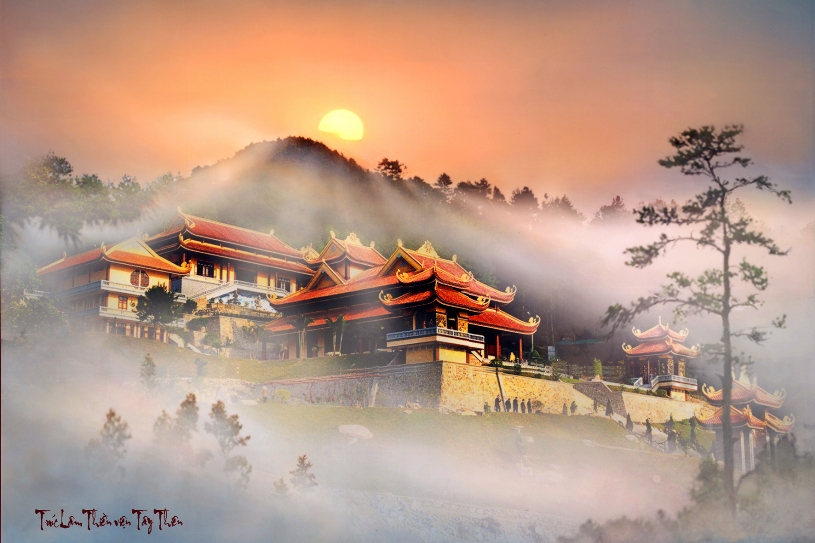Rhythms of a Zen Monastery
If we were to stay at a Zen monastery, what would we expect to find there and how might our experience grow if we were to extend our stay there? The answer to this first lies in the definition of what a Zen monastery is. In his book Awakening: An Introduction to the History of Eastern Thought, author Patrick Bresnan defines a Zen monastery simply as "a community of monks living and working together under the guidance of a roshi...in the shared belief that the communal way of living offers the within which to follow Buddha's path leading to Enlightenment. The roshi, an already enlightened man or woman, will oversee the life of the community and personally guide the development of each of the monks." (Bresnan, 502) Whether the Zen monastery is located in a busy city or somewhere remote, it is "a place of great tranquility and beauty" where "one has the feeling of entering another realm" and "everything-grounds, buildings and other structures-all fit together with the surrounding environment in a perfect harmony". (Bresnan, 503) Among the collection of buildings in the monastery, the most important is the Zendo, where the community gathers for zazen, meditation practice. Among the buildings typically are the dormitory where the monks sleep, separate quarters for the roshi, a bathhouse with an extremely hot soaking tub for soaking (not cleaning), a dining hall, a kitchen, and a fruit and vegetable garden to help "achieve the greatest possible degree of self-sufficiency". (Bresnan, 503) Among the other core elements usually found in the Zen monastery are the Ogane (the monastery bell), a shrine with a statue of Shakyamani Buddha, an infirmary, and a library. "Everything about a Zen monastery is designed to promote serenity and the meditative state of mind." (Bresnan, 506)Truc Lam Tay Thien Zen Monastery in Tam Dao Mountain (www.indochinatravelpackages.com)
Ultimately though, it is not the look of the monastery or how many buildings and shrines are on the grounds that is the core of the monastery. "The daily routine of the members of the community is the lifeblood of Zen Buddhism." (Bresnan, 507) What then are the rhythms of this daily routine and how might we participate if were to visit or even live and practice at the monastery? The day begins before dawn at the Zendo with passages recited from the sutras and an hour of sitting meditation. This is followed by a simple vegetarian breakfast, then cleaning and sweeping the monastery before attending to the day's core work or study with a light lunch halfway through. In the late afternoon there is another Zendo session with passages recited from the sutras and an hour of sitting meditation. The evening meal leads to the close of the day with another zazen session and possibly a dokusan, consultation with the roshi about one's progress on the path to Enlightenment. Sleep comes around nine or ten in the evening. The rhythm changes sometimes with a shift to constant focus on zazen with a sesshin, meditation that may go on continuously for up to twelve hours. Throughout these rhythms of the Zen monastery, silence and mindfulness are the keynotes. "Outer silence helps to quiet the habitual inner chatter of the thinking mind. Speaking is not forbidden, but by mutual agreement talking is limited to only what is necessary...Mindfulness and verbosity are mutually exclusive." (Bresnan, 514)
This is an in-depth look at the first Western woman who was given permission to participate in Zen training at a Japanese Zen monastery, and the daily rhythms of a Japanese Rinzai Zen monastery.
I have no doubt that I would enjoy time spent at a Zen monastery. A friend of mine practices Zen Buddhism. I spent a day with her at the San Francisco Zen Center and sat in a zazen session. Though the session was very long and difficult for a novice like me to sit in the position with my back straight and with mindfulness, a great sense of peace and merging with the whole of things came over me during the session (along with the pain and discomfort of sitting in the position for so long). The sense of presence and purpose that I felt there left me with the intention to practice and explore what more is in store.
The Zendo at the San Francisco Zen CenterWorks Cited
Bresnan, Patrick S. Awakening, An Introduction to the History of Eastern Thought. Routledge 2018
Van Dijk, Tom. Zen Meditation and Chanting. Japanese Zen Buddhist Monastery SogenJi. youtube.com, Accessed 3 May 2022


Comments
Post a Comment